Quantitative Detection of Defects in Multi-Layer Lightweight Composite Structures Using THz-TDS Based on a U-Net-BiLSTM Network
Abstract
:1. Introduction
2. Experiments
2.1. THz Detection System
2.2. Sample Preparation
2.3. Dataset Labeling
2.4. U-Net-BiLSTM Network Architecture
3. Results and Discussion
3.1. Evaluation Metrics
3.2. Recognition Results
4. Conclusions
Author Contributions
Funding
Data Availability Statement
Conflicts of Interest
References
- Pomarède, P.; Miqoi, N.; Christophe, D.; Citrin, D.S.; Meraghni, F.; Locquet, A. Terahertz pulsed imaging of low velocity impact damage in woven fiber composite laminates. J. Compos. Mater. 2023, 57, 4719–4730. [Google Scholar] [CrossRef]
- Qian, H.; Zhang, C.; Qiu, J.; Tao, C.; Ji, H. Research of Effects of Temperature Change and Thermal Cycles on Lamb Waves in the Thermal Protection Structure. In Proceedings of the 2022 Global Reliability and Prognostics and Health Management (PHM-Yantai), Yantai, China, 13–16 October 2022; pp. 1–4. [Google Scholar] [CrossRef]
- Latha, A.M.; Devi, A.S.N. Automatic Threat Object Detection from THz Images using Artificial Intelligence Algorithms. In Proceedings of the 2023 24th International Vacuum Electronics Conference (IVEC), Chengdu, China, 25–28 April 2023; pp. 1–3. [Google Scholar] [CrossRef]
- Bharadwaj, A.N.; Kashyap, A.M.; Bhatta, N.G.; Jayachandran, R.; Kishore, R. A Survey on Terahertz Devices-A cutting edge Technology. In Proceedings of the 2023 International Conference on Recent Trends in Electronics and Communication (ICRTEC), Mysore, India, 10–11 February 2023; pp. 1–6. [Google Scholar] [CrossRef]
- Nsengiyumva, W.; Zhong, S.; Luo, M.; Wang, B. Terahertz Spectroscopic Characterization and Thickness Evaluation of Internal Delamination Defects in GFRP Composites. Chin. J. Mech. Eng. 2023, 36, 6. [Google Scholar] [CrossRef]
- Li, J.; Yang, L.; He, Y.; Li, W.; Wu, C. Terahertz Nondestructive Testing Method of Oil-paper Insulation Debonding and Foreign Matter Defects. IEEE Trans. Dielectr. Electr. Insul. 2021, 28, 1901–1908. [Google Scholar] [CrossRef]
- Nsengiyumva, W.; Zhong, S.; Zheng, L.; Liang, W.; Wang, B.; Huang, Y.; Chen, X.; Shen, Y. Sensing and non-destructive testing applications of terahertz spectroscopy and imaging systems: State-of-the-art and state-of-the-practice. IEEE Trans. Instrum. Meas. 2023, 72, 4507483. [Google Scholar] [CrossRef]
- Li, Y.; Xie, C.; Gou, B.; Yu, S.; Yang, C. Terahertz Detection of Interface Defects Within Composite Insulators Using a Gated Recurrent Neural Network. IEEE Trans. Dielectr. Electr. Insul. 2023. [Google Scholar] [CrossRef]
- Jiang, H.; Mei, H.; Bian, X.; Li, L.; Wang, L.; Wang, L. Detection of Double-layer Air Gap Defects Based on Terahertz Imaging Method. In Proceedings of the 2021 IEEE International Instrumentation and Measurement Technology Conference (I2MTC), Glasgow, UK, 17–20 May 2021; pp. 1–5. [Google Scholar] [CrossRef]
- Jiang, X.; Xu, Y.; Zhao, D. Terahertz Non-destructive testing and imaging of corrosion in coated steel plates. Constr. Build. Mater. 2023, 385, 131427. [Google Scholar] [CrossRef]
- Gupta, R.; Mitchell, D.; Blanche, J.; Harper, S.; Tang, W.; Pancholi, K.; Baines, L.; Bucknall, D.G.; Flynn, D. A Review of Sensing Technologies for Non-Destructive Evaluation of Structural Composite Materials. J. Compos. Sci. 2021, 5, 319. [Google Scholar] [CrossRef]
- Chowdhury, M.A.Z.; Rice, T.E.; Oehlschlaeger, M.A. VOC-Net: A Deep Learning Model for the Automated Classification of Rotational THz Spectra of Volatile Organic Compounds. Appl. Sci. 2022, 12, 8447. [Google Scholar] [CrossRef]
- Klokkou, N.; Gorecki, J.; Apostolopoulos, V. THz-TDS Parameter Extraction via Machine Learning. In Proceedings of the 2021 46th International Conference on Infrared, Millimeter and Terahertz Waves (IRMMW-THz), Chengdu, China, 29 August–3 September 2021; pp. 1–2. [Google Scholar] [CrossRef]
- Wang, Q.; Liu, Q.; Xia, R.; Zhang, P.; Zhou, H.; Zhao, B.; Li, G. Automatic defect prediction in glass fiber reinforced polymer based on THz-TDS signal analysis with neural networks. Infrared Phys. Technol. 2021, 115, 103673. [Google Scholar] [CrossRef]
- Zhang, Z.; Peng, G.; Tan, Y.; Pu, T.; Wang, L. THz wave detection of gap defects based on convolutional neural network improved by residual shrinkage network. CSEE J. Power Energy Syst. 2020, 9, 1078–1089. [Google Scholar]
- Xiong, W.; Ren, J.; Zhang, J.; Zhang, D.; Gu, J.; Xue, J.; Chen, Q.; Li, L. Defect identification in adhesive structures using multi-Feature fusion convolutional neural network. Front. Phys. 2023, 10, 1351. [Google Scholar] [CrossRef]
- Akter, N.; Siddiquee, M.R.; Shur, M.; Pala, N. AI-Powered Terahertz VLSI Testing Technology for Ensuring Hardware Security and Reliability. IEEE Access 2021, 9, 64499–64509. [Google Scholar] [CrossRef]
- Mikerov, M.; Ornik, J.; Koch, M. Removing Water Vapor Lines from THz-TDS Data Using Neural Networks. IEEE Trans. Terahertz Sci. Technol. 2020, 10, 397–403. [Google Scholar] [CrossRef]
- Chen, J.; Sun, Y.; Sun, K.; Li, X. Automatic Onsets and Systolic Peaks Detection and Segmentation of Arterial Blood Pressure Waveforms using Fully Convolutional Neural Networks. In Proceedings of the 43rd Annual International Conference of the IEEE Engineering in Medicine & Biology Society (EMBC), Guadalajara, Mexico, 1–5 November 2021; pp. 5674–5677. [Google Scholar]
- Peng, X.; Zhu, H.; Zhou, X.; Pan, C.; Ke, Z. ECG Signals Segmentation Using Deep Spatiotemporal Feature Fusion U-Net for QRS Complexes and R-Peak Detection. IEEE Trans. Instrum. Meas. 2023, 72, 2506212. [Google Scholar] [CrossRef]
- Bawuah, P.; Zeitler, J.A. Advances in terahertz time-domain spectroscopy of pharmaceutical solids: A review. TrAC Trends Anal. Chem. 2021, 139, 116272. [Google Scholar] [CrossRef]
- Hernandez-Cardoso, G.G.; Amador-Medina, L.F.; Gutierrez-Torres, G.; Reyes-Reyes, E.S.; Benavides Martínez, C.A.; Cardona Espinoza, C.; Acre Cruz, J.; Salas-Gutierrez, I.; Murillo-Ortíz, B.O.; Castro-Camus, E. Terahertz imaging demonstrates its diagnostic potential and reveals a relationship between cutaneous dehydration and neuropathy for diabetic foot syndrome patients. Sci. Rep. 2022, 12, 3110. [Google Scholar] [CrossRef]
- Karimi, A.; Faez, K.; Nazari, S. DEU-Net: Dual-Encoder U-Net for Automated Skin Lesion Segmentation. IEEE Access 2023, 11, 134804–134821. [Google Scholar] [CrossRef]
- Freire, P.J.; Osadchuk, Y.; Spinnler, B.; Napoli, A.; Schairer, W.; Costa, N.; Prilepsky, J.E.; Turitsyn, S.K. Performance versus Complexity Study of Neural Network Equalizers in Coherent Optical Systems. J. Light. Technol. 2021, 39, 6085–6096. [Google Scholar] [CrossRef]
- Ibrahim, M.; Badran, K.M.; Hussien, A.E. Artificial intelligence-based approach for Univariate time-series Anomaly detection using Hybrid CNN-BiLSTM Model. In Proceedings of the 2022 13th International Conference on Electrical Engineering (ICEENG), Cairo, Egypt, 29–31 March 2022; pp. 129–133. [Google Scholar] [CrossRef]
- Cho, M.; Kim, C.; Jung, K.; Jung, H. Water Level Prediction Model Applying a Long Short-Term Memory (LSTM)–Gated Recurrent Unit (GRU) Method for Flood Prediction. Water 2022, 14, 2221. [Google Scholar] [CrossRef]
- Bhattacharjee, A.; Murugan, R.; Goel, T.; Soni, B. Semantic segmentation of lungs using a modified U-Net architecture through limited Computed Tomography images. In Proceedings of the 2021 Advanced Communication Technologies and Signal Processing (ACTS), Rourkela, India, 15–17 December 2021; pp. 1–6. [Google Scholar] [CrossRef]
- Shin, Y.; Kim, Y.G.; Choi, C.-H.; Kim, D.-J.; Chun, C. SELD U-Net: Joint Optimization of Sound Event Localization and Detection with Noise Reduction. IEEE Access 2023, 11, 105379–105393. [Google Scholar] [CrossRef]
- Shabankareh, S.G. Improvement of Edge-Tracking Methods using Genetic Algorithm and Neural Network. In Proceedings of the 2019 5th Iranian Conference on Signal Processing and Intelligent Systems (ICSPIS), Shahrood, Iran, 18–19 December 2019; pp. 1–7. [Google Scholar] [CrossRef]
- Zarrinkhat, F.; Pentland, A.; Reynolds, C.; Kendrick, E.; Taday, P.F. Using Terahertz Time-domain Spectroscopy to Measure Coating Thickness on Li-ion Electrodes. In Proceedings of the 2023 48th International Conference on Infrared, Millimeter, and Terahertz Waves (IRMMW-THz), Montreal, QC, Canada,, 17–22 September 2023; pp. 1–2. [Google Scholar] [CrossRef]
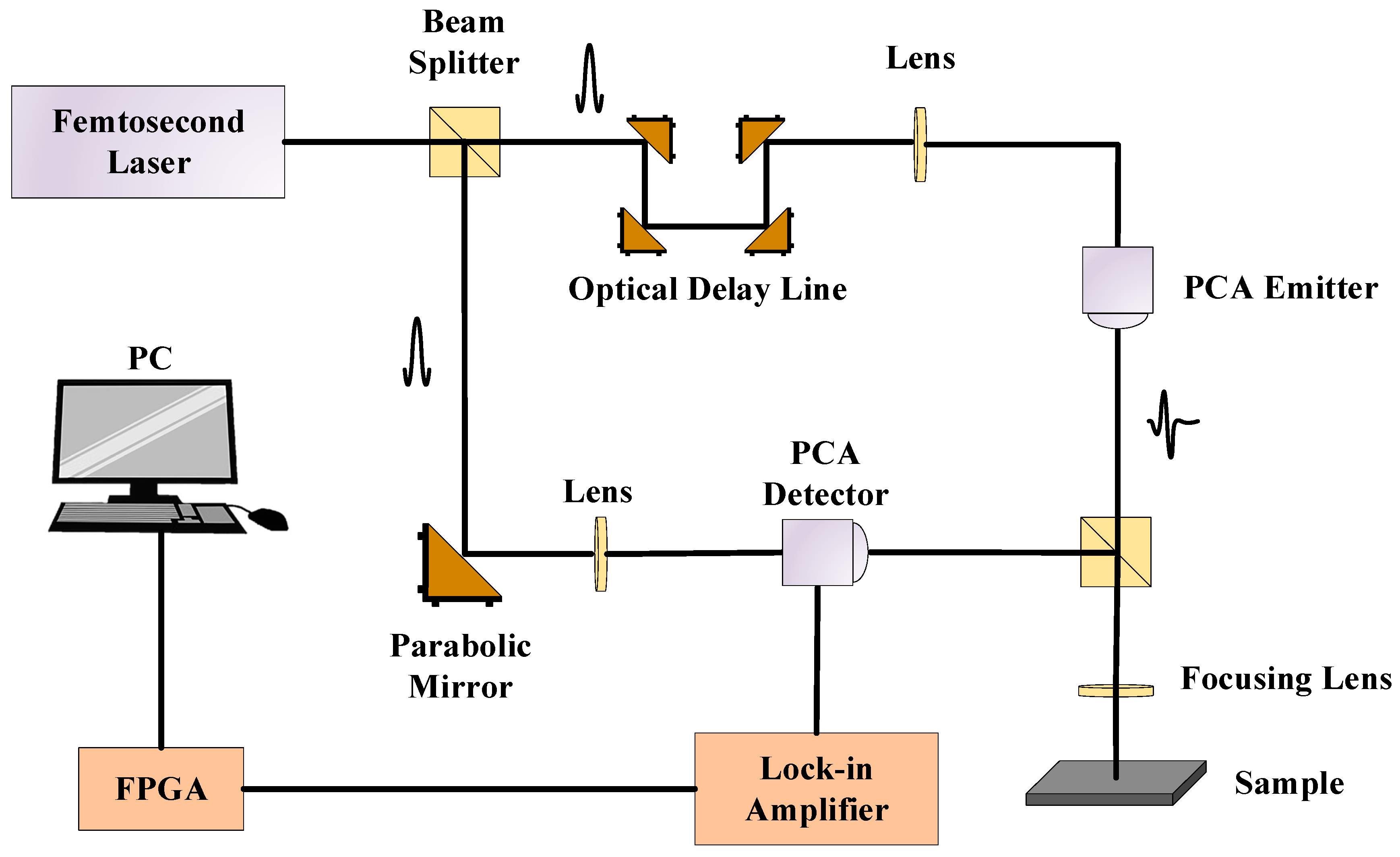
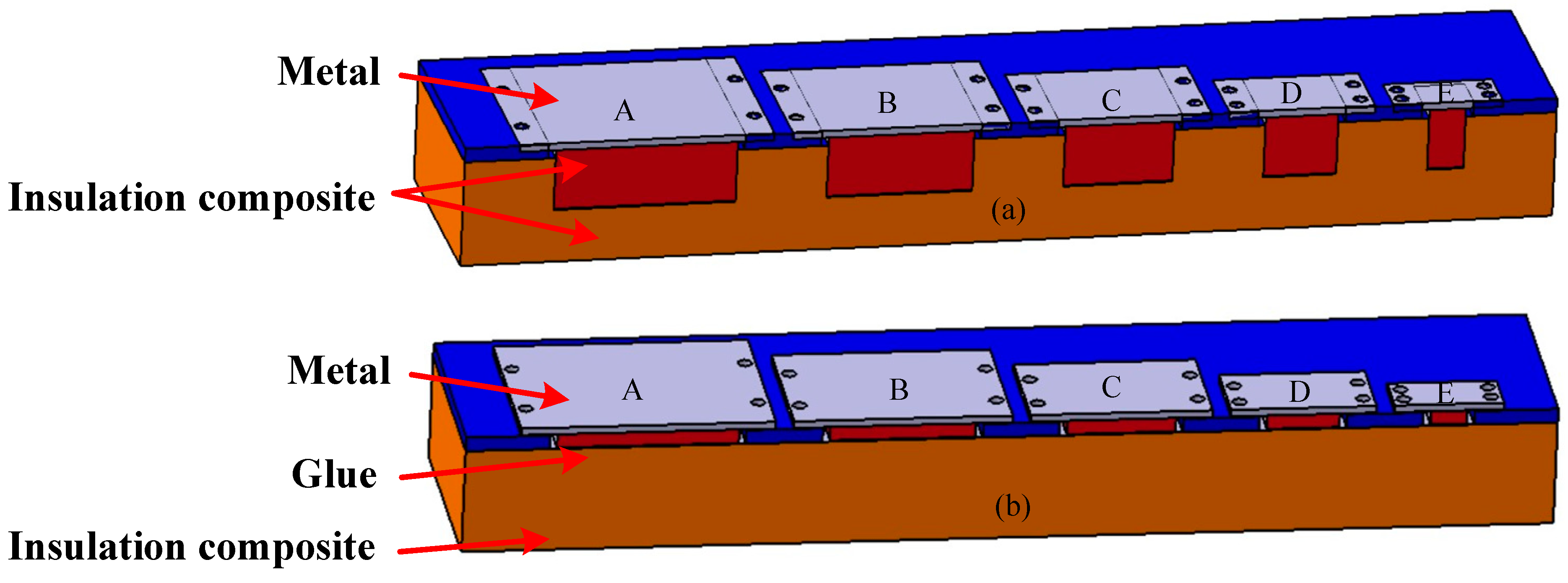

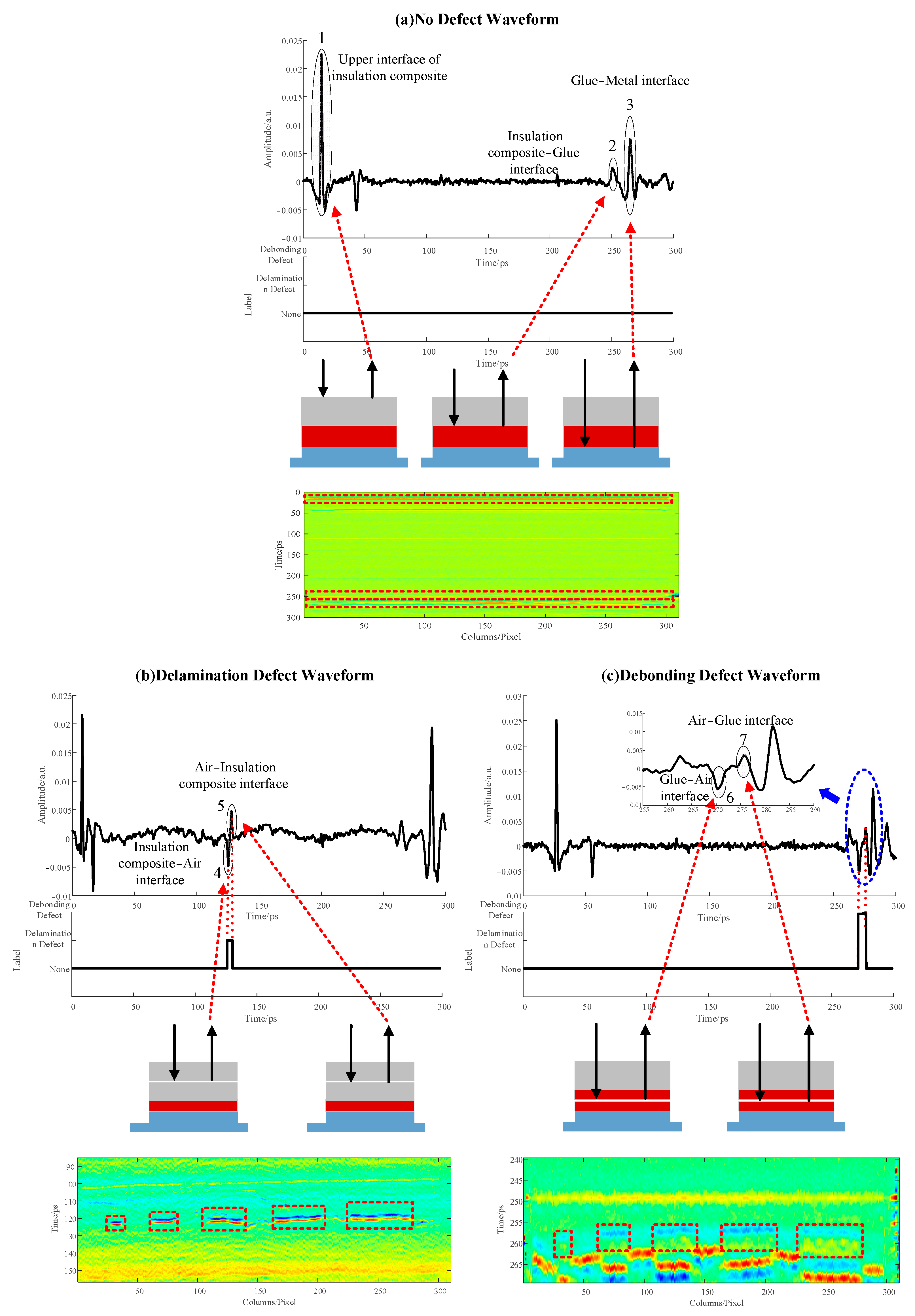
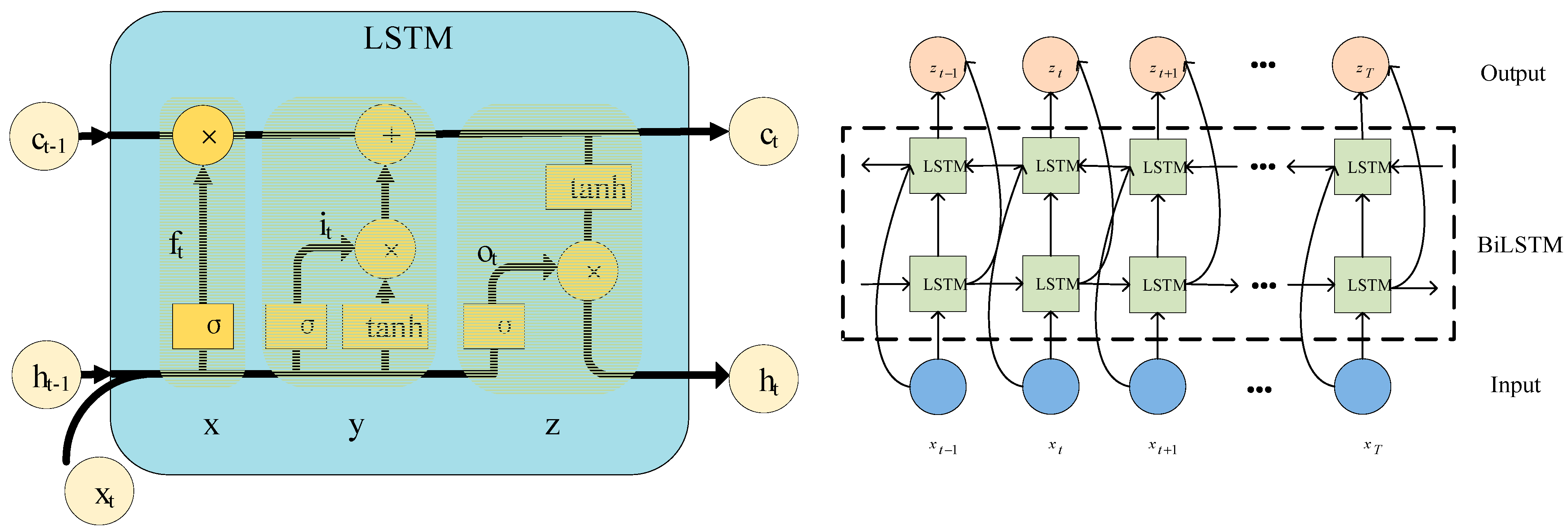

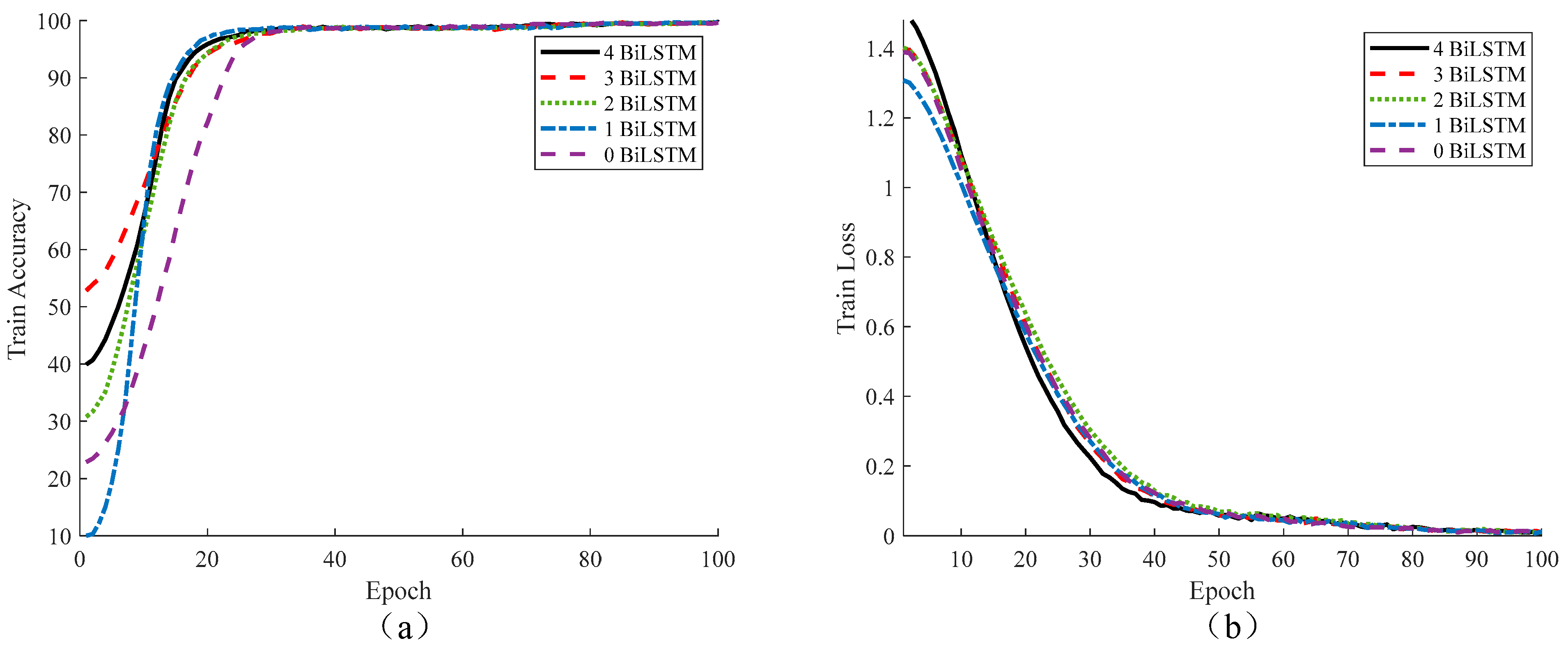


| Defect Type | Area A (mm × mm) | Area B (mm × mm) | Area C (mm × mm) | Area D (mm × mm) | Area E (mm × mm) |
|---|---|---|---|---|---|
| Debonding | 50 × 50 | 40 × 40 | 30 × 30 | 20 × 20 | 10 × 10 |
| Delamination | 50 × 50 | 40 × 40 | 30 × 30 | 20 × 20 | 10 × 10 |
| Model | Acc (%) | Sen (%) | Spe (%) | Pre (%) | F1 (%) |
|---|---|---|---|---|---|
| U-Net-BiLSTM | 99.45 | 99.39 | 99.51 | 99.48 | 99.43 |
| CNN | 98.07 | 97.21 | 98.93 | 98.92 | 98.06 |
| ResNet | 97.34 | 95.49 | 99.14 | 99.13 | 97.27 |
| U-net | 98.76 | 98.87 | 98.65 | 98.63 | 98.75 |
| BiLSTM | 98.68 | 98.47 | 98.90 | 98.88 | 98.67 |
| Method | A | B | C | D | E | Error | |
|---|---|---|---|---|---|---|---|
| Delamination defect thickness (mm) | Artificial | 0.9629 | 0.4896 | 0.9046 | 0.6414 | 0.6737 | — |
| U-net-BiLSTM | 0.9495 | 0.4778 | 0.9584 | 0.5943 | 0.7035 | 0.0538 | |
| CNN | 0.9255 | 0.4667 | 0.8325 | 0.5587 | 0.5990 | 0.0827 | |
| ResNet | 0.9029 | 0.4657 | 0.8588 | 0.5208 | 0.5342 | 0.1395 | |
| U-net | 0.9419 | 0.4568 | 0.9706 | 0.5740 | 0.7317 | 0.0674 | |
| BiLSTM | 0.9344 | 0.4542 | 0.9873 | 0.5841 | 0.7196 | 0.0827 | |
| Debonding defect thickness (mm) | Artificial | 1.1229 | 0.9888 | 0.9946 | 0.9034 | 0.7736 | — |
| U-net-BiLSTM | 1.0655 | 0.9734 | 0.9714 | 0.8573 | 0.7606 | 0.0574 | |
| CNN | 0.9525 | 0.9869 | 0.9615 | 0.8448 | 0.7960 | 0.1704 | |
| ResNet | 0.9779 | 1.0105 | 0.9505 | 0.8395 | 0.8540 | 0.1450 | |
| U-net | 1.0375 | 0.9814 | 0.9627 | 0.8552 | 0.7545 | 0.0854 | |
| BiLSTM | 0.9913 | 0.9658 | 0.9633 | 0.8427 | 0.8156 | 0.1316 | |
| Delamination defect area (mm2) | Artificial | 2455 | 1496 | 839 | 350 | 78 | — |
| U-net-BiLSTM | 2434 | 1502 | 821 | 347 | 69 | 57 | |
| CNN | 2403 | 1464 | 752 | 339 | 55 | 205 | |
| ResNet | 2399 | 1458 | 775 | 335 | 45 | 206 | |
| U-net | 2475 | 1480 | 816 | 342 | 63 | 82 | |
| BiLSTM | 2413 | 1517 | 824 | 338 | 67 | 101 | |
| Debonding defect area (mm2) | Artificial | 2621 | 1675 | 847 | 361 | 67 | — |
| U-net-BiLSTM | 2654 | 1691 | 850 | 348 | 75 | 73 | |
| CNN | 2685 | 1715 | 854 | 331 | 63 | 145 | |
| ResNet | 2678 | 1752 | 884 | 368 | 75 | 186 | |
| U-net | 2667 | 1702 | 866 | 345 | 64 | 111 | |
| BiLSTM | 2659 | 1723 | 857 | 344 | 60 | 120 |
Disclaimer/Publisher’s Note: The statements, opinions and data contained in all publications are solely those of the individual author(s) and contributor(s) and not of MDPI and/or the editor(s). MDPI and/or the editor(s) disclaim responsibility for any injury to people or property resulting from any ideas, methods, instructions or products referred to in the content. |
© 2024 by the authors. Licensee MDPI, Basel, Switzerland. This article is an open access article distributed under the terms and conditions of the Creative Commons Attribution (CC BY) license (https://creativecommons.org/licenses/by/4.0/).
Share and Cite
Zhang, D.; Li, L.; Zhang, J.; Ren, J.; Gu, J.; Li, L.; Jiang, B.; Zhang, S. Quantitative Detection of Defects in Multi-Layer Lightweight Composite Structures Using THz-TDS Based on a U-Net-BiLSTM Network. Materials 2024, 17, 839. https://doi.org/10.3390/ma17040839
Zhang D, Li L, Zhang J, Ren J, Gu J, Li L, Jiang B, Zhang S. Quantitative Detection of Defects in Multi-Layer Lightweight Composite Structures Using THz-TDS Based on a U-Net-BiLSTM Network. Materials. 2024; 17(4):839. https://doi.org/10.3390/ma17040839
Chicago/Turabian StyleZhang, Dandan, Lulu Li, Jiyang Zhang, Jiaojiao Ren, Jian Gu, Lijuan Li, Baihong Jiang, and Shida Zhang. 2024. "Quantitative Detection of Defects in Multi-Layer Lightweight Composite Structures Using THz-TDS Based on a U-Net-BiLSTM Network" Materials 17, no. 4: 839. https://doi.org/10.3390/ma17040839





